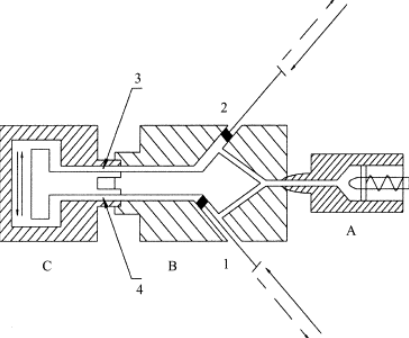Orientation of short fibers in powder injection molded aluminum matrix composites
Author: Faiz Ahmad - November 2005
Abstract
This research demonstrates the application of Multiple Live Feed Molding (MLFM) device for controlling the fiber orientations in powder injection molded aluminum composites. Experiments were performed for a range of powder/fibers composite mixes by using both Multiple Live Feed Molding device and molding technique. Optimum MLFM process parameters were identified to achieve the highest level of fiber orientation in aluminum composite test bars. Fiber orientation was measured in two planes of molded test bars. Average orientation angle "0" was determined and orientation factor "f" was calculated for composite moldings produced. This investigation has identified the molding composition to achieve the highest level of fiber orientations in a preferred direction, which should result in increased directional mechanical properties
Methodology
Composite mixes contained 65 vol% of powder plus fiber and 35 vol% binder. Volume percent of fibers is based on total solids in the final component. Binder consists of polypropylene (pp) -23.45 vol%, microcrystalline wax -7.70 vol% and stearic acid -3.85 vol%. Mixes FC1, FC2, FC3 and FC4 were compounded using this binder. In order to affect the viscosity of FC5 and FC6, the percentage of microcrystalline wax was reduced and stearic acid was also eliminated. FC5 was compounded with a binder B2 containing polypropylene -27.30 vol% and microcrystalline wax -7.70 vol%. FC6 was mixed with a binder B3 consisting of polypropylene -31.15 vol% and microcrystalline wax -3.85 vol%. FC4, FC5 and FC6 were used to investigate the effects of viscosity on fiber orientations. FC1, FC2 and FC3 were used to study the effects of fiber volume fraction on the orientation of fiber. FC1, FC2 and FC3 were called type "A" and composite mixes FC4, FC5 and FC6 were called type "B". Samples produced using MLFM device were called MLF and those produced by conventional molding technique were called "conventional".
Impact & Benefits
Strength and Stiffness:Controlling fiber orientation in MMCs significantly enhances mechanical properties such as tensile strength, stiffness, and load-bearing capacity. This is particularly crucial for applications requiring high-performance materials.
Internal Weld Line Strength: The MLFM device improves internal weld line strength, which is critical for the structural integrity of composite parts. Enhanced weld lines lead to fewer defects and higher reliability.
Complex Geometries:PIM allows for the production of complex and intricate geometries that would be challenging or impossible with traditional manufacturing techniques. This broadens the application scope of MMCs.
Reduced Material Waste:By precisely controlling fiber orientation and using PIM, there is less material waste, leading to cost savings in production.
Automotive Industry: Enhanced MMCs can be used in engine components, brake discs, and structural parts, leading to lighter vehicles with better fuel efficiency.
SEM and Image Processing: The development of advanced characterization techniques like SEM and image processing allows for precise measurement and control of fiber orientations. This leads to better understanding and optimization of composite properties.
Findings/Figures and Research Data
The corresponding SEM micrograph of FC2 showing the preferred orientation in the core region of molding is shown in Fig. 3b. The degree of fiber orientation in the flow direction can be seen from SEM picture. Viscosity of composite mixes FC1, FC2 and FC3 increases with the increase in fiber volume fraction for 10, 15 and 20%, respectively. The orientation of fibers observed in MLF specimens also indicated that viscosity does not have appreciable effect on the fiber orientation processed with MLFM device. Results also showed that FC2 has a maximum number of fibers oriented in the flow direction and average orientation angle was 13 °, whereas the same for FC3 was 23 ° and 18 ° for FC1.
Market Potential
Automotive Industry:MMCs offer high strength-to-weight ratios, making them ideal for automotive applications aiming for weight reduction and improved fuel efficiency.
Aerospace Industry:The aerospace industry demands materials that can withstand extreme conditions. MMCs with controlled fiber orientations can provide superior mechanical properties, such as improved tensile strength and fatigue resistance.
Defense and Military:MMCs can be used in the development of lightweight, high-strength armors and protective gear.
Electronics and Thermal Management:The excellent thermal conductivity of MMCs makes them suitable for use in electronic heat sinks and thermal management systems.

